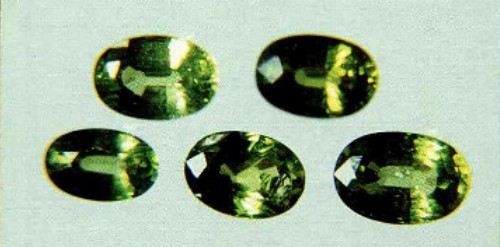
The colour range of Paraiba tourmalines
First published in Facette 29 (May 2024)

Paraiba tourmalines owe their attractive colour to the presence of copper. In the best case, this gives rise to a vivid blue colour, also known in the trade as ‘neon’ blue or ‘electric’ blue and not known from any other gemstone in nature.
In the last SSEF Facette, we discussed the criterion of colour saturation towards classifying a copper-bearing tourmaline as Paraiba tourmaline (see SSEF Facette 2023, page 35). As was shown, tourmalines of very low blue saturation do not qualify to be called Paraiba tourmaline, even if their light blue colour is caused by traces of copper.
This time, we would like to clarify about the colour range of Paraiba tourmaline. It is well-known that copper-bearing tourmalines from Paraiba in Brazil, but also from Nigeria and Mozambique come in a rather large colour range (Figure 1). Copper-bearing tourmaline may be found in purple, deep blue, greenish blue, bluish green, vivid green to greenish yellow colours. Sometimes a mix of these colours are even found in a single zoned tourmaline crystal. The reason for this colour range is the contribution of other chromophores such as manganese and iron in the absorption spectra of these copper-bearing tourmalines.
At SSEF, the term Paraiba tourmaline is mentioned on a report only if the colour of the copper-bearing tourmaline ranges from deep blue to vivid green. Purple or greenish yellow to yellowish green stones containing distinct amounts of copper, however, are only described as copper- bearing tourmalines on SSEF reports.
It is important to know that most copper-bearing tourmalines are heat treated to enhance their colour. This is especially the case with originally purple (or greyish purple) Cu-bearing tourmalines. They are heated at about 550 °C with the aim of shifting their colour to an attractive Paraiba-blue colour. In other words, the purple colour of a copper-bearing tourmaline is proof that this stone had not been heated. This is also valid for stones containing purple zones or a tiny purple halo around a hollow channel as seen on the right in Figure 2.



